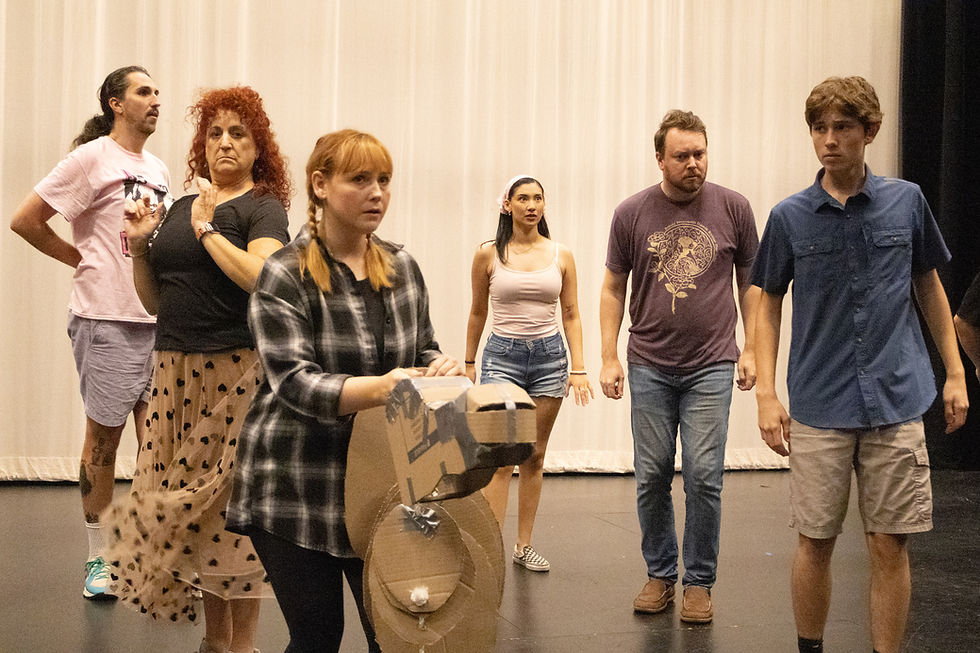“The Miracle Worker” at Cabrillo Playhouse
- OC Theatre Guild
- May 26
- 4 min read

The True Story Of The Wondrous Power Of Love And Learning!
By Bruce Goodrich
William Gibson’s “The Miracle Worker” (1960), is one of the great modern realist, historically based plays, in the tradition of “The Diary of Anne Frank” (1955) and “Inherit the Wind” (1955), among others. Adapted from Gibson’s 1957 Playhouse 90 teleplay of the same name, it is based on Helen Keller’s 1903 autobiography “The Story of My Life.”
Opening June 6 at the 72-year-old Cabrillo Playhouse, the production is directed by Abigail Cox and staged in their historic building in San Clemente, which dates back to the late 1920s.
The play tells the story of Helen Keller (1880-1968), who, as an infant, succumbed to an illness—likely scarlet fever or meningitis—that left her deaf and blind. Raised in the middle-class Keller family home in Tuscumbia, Alabama, Helen became a wild, tantrum-throwing child, pitied and spoiled by her parents. At the age of six, the family hires a young, visually impaired governess and teacher, Anne Sullivan (1866–1936), to see if she can, in some way, reach Helen and draw her out of her hermetic shell.
What follows is an extraordinary true story of Sullivan’s powerful resolve to teach Helen, using her own unconventional methods—despite the family's initial skepticism, particularly that of former Confederate Army Captain Mr. Keller. As a result of Sullivan’s perseverance and compassion, Helen awakens to the power of language and human expression.

This is Cox’s first production at the Playhouse, and she felt a particular affinity for the play, as several of her family members are deaf. Though she had never seen the film or a stage performance, she was assigned to read the play and research the life of Helen Keller in elementary school, subsequently giving a report to her class in costume as Helen. With that fortuitous underpinning, she was drawn to the play's portrayal of Sullivan-- a strong, independent woman in a pre-feminist era-- who taught on her own terms and helped shape a desperately troubled young lady into someone just as fiercely independent.
Cox’s training and experience as a paraeducator working with children with special needs proved invaluable in directing the intense physical and emotional conflicts between Helen and Anne. It also helped that ten-year-old Annabelle Finch, who plays the seven-year-old Helen, is a trained dancer with an acute awareness of how her body moves, which allows her to safely and effectively perform the play’s physically demanding tantrum scenes.
A technical design challenge for this production was dealing with the fairly low height of the stage house. While the script calls for a two-story depiction of the Keller home, renovations to raise the stage house ceiling won’t be completed until after this production. To accommodate, the production team creatively suggested two floors with a single level set.

While the play is typically presented in a straightforward realistic style-- and Cox largely honors that tradition-- she chose to enhance one dramatic moment with lighting and sound effects: Anne’s hallucinations of her younger brother, who died of tuberculosis while they lived together in an almshouse, after their father abandoned them.
The three-act play spans roughly a month, during which time Sullivan led Keller to her life-changing breakthrough, at the beginning of April, 1887. In dramatic structure the play is a tour de force for the two lead characters of Sullivan and Keller, especially Keller, typically played by a child or early teen actor. The two must forge a powerful bond, both as characters and actors, to entirely suspend our disbelief, regarding Helen’s handicaps. For this production, the two lead actors have done just that, becoming good friends, during the process, which adds immeasurably to the verisimilitude the play needs, in order to deeply touch our hearts, rendering the unwavering power of the human spirit.
Anne Sullivan’s groundbreaking teaching methods became universally codified. She and Helen remained lifelong friends. Helen went on to attend Radcliffe College of Harvard University, graduating with a Bachelor of Arts in 1904-- becoming the first deaf-blind person to do so. She became a world-renowned speaker, author, and advocate for people with disabilities. Keller was a suffragist, pacifist, Christian socialist, birth control advocate, and supporter of the NAACP. In 1920, she helped found the American Civil Liberties Union (ACLU).
Bruce Goodrich is a scenic and costume designer, with many NYC, SoCal and regional credits, as well as being an educator, actor and writer. He is the screenwriter for “Mapplethorpe,” (2018) starring Matt Smith, developed at Sundance, and directed by Ondi Timoner.
“The Miracle Worker”
Cabrillo Playhouse
202 Avenida Cabrillo, San Clemente, CA
June 6 - June 29, 2025
(949) 492-0465, cabrilloplayhouse.org




Comments